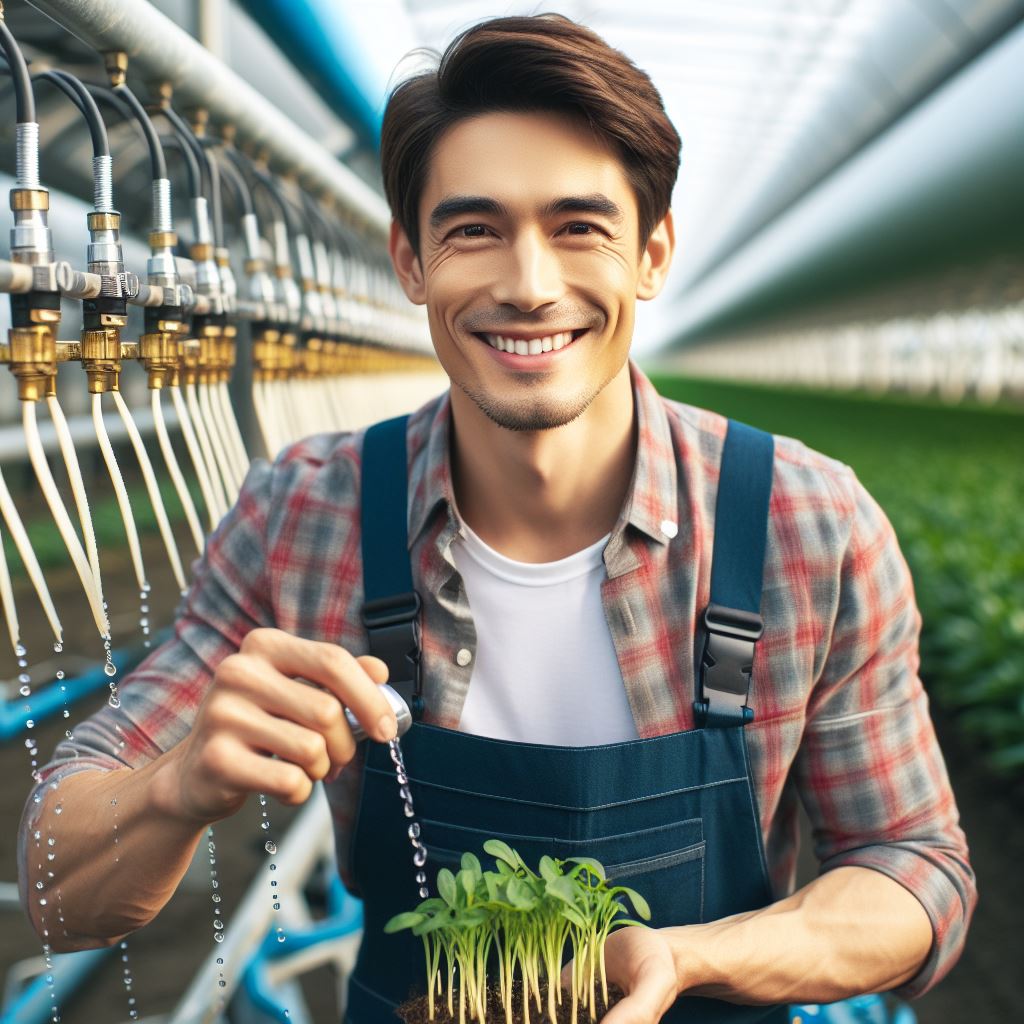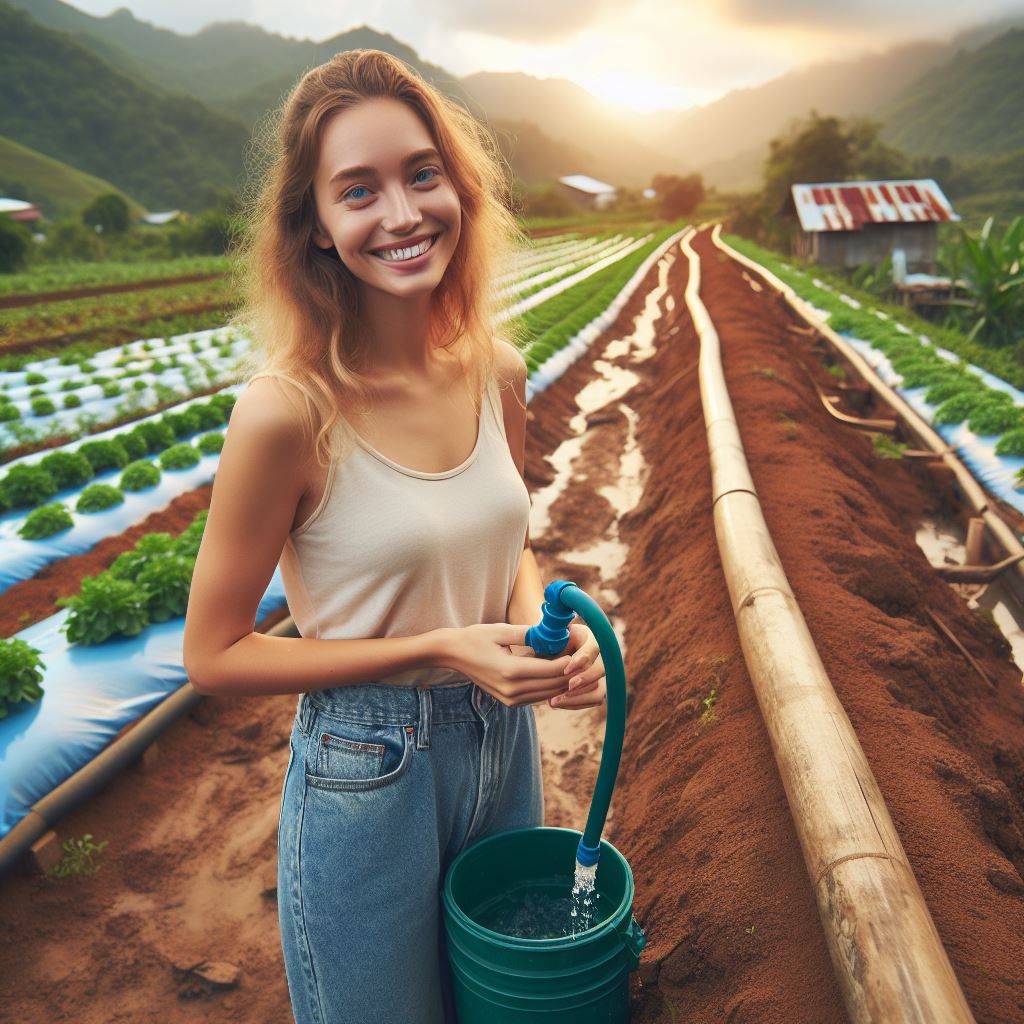Introduction
Precision agriculture is a modern farming technique that aims to optimize crop production by using technology.
Its main goal is to maximize yield while minimizing both input costs and environmental impact.
One crucial aspect of precision agriculture is the efficient use of water resources.
Balancing water usage and crop yield is vital to ensure sustainable and profitable farming practices.
By implementing precision irrigation techniques, farmers can monitor and control the amount of water delivered to crops based on their specific needs, thereby avoiding water wastage and improving water-use efficiency.
This not only helps conserve water resources but also reduces energy consumption and lowers irrigation costs.
Balancing water usage is particularly crucial in regions experiencing water scarcity or erratic rainfall patterns.
Precision agriculture enables farmers to optimize irrigation schedules, adjust watering levels according to soil moisture levels, and manage water distribution based on the crop’s growth stage.
By doing so, farmers can avoid both over-irrigation and under-irrigation, ensuring optimal crop growth and maximum yield.
Precision agriculture also relies on various tools and technologies, such as soil sensors, satellite imagery, and in-field weather stations, to gather data and provide real-time information on soil moisture, water needs, and weather conditions.
This information helps farmers make informed decisions regarding irrigation, leading to improved water management and higher crop productivity.
In fact, precision agriculture plays a crucial role in achieving the delicate balance between water usage and crop yield.
By employing smart irrigation technologies and techniques, farmers can reduce water wastage, increase water-use efficiency, and optimize crop production, ensuring both economic viability and environmental sustainability.
Understanding Water Needs in Precision Agriculture
Water is a vital resource for crop growth, but different crops have varying water requirements.
With precision agriculture, it is essential to accurately measure and monitor the water needs of crops using advanced technologies and tools.
Different Crops, Different Water Requirements
Each crop has distinct water needs to achieve optimal growth and yield.
Understanding these requirements is crucial for effective water management in precision agriculture.
For instance, water-sensitive crops like lettuce and tomatoes require a more consistent water supply.
On the other hand, crops like corn and beans are more drought-tolerant and can withstand water stress to a certain extent.
Fruit crops, such as grapes and berries, have specific watering demands during different growth stages.
They need precise irrigation schedules to balance water availability with the desired fruit quality and yield.
By understanding the specific water requirements of different crops, farmers can tailor their irrigation techniques accordingly, ensuring efficient water usage and maximizing crop productivity.
Accurate Measurement and Monitoring
Precision agriculture depends on accurate measurement and monitoring of crop water needs.
This requires reliable data and real-time information to make informed decisions.
The use of sensors plays a pivotal role in measuring soil moisture levels, which directly correlates with crop water requirements.
These sensors provide data on the water content of the soil, enabling farmers to determine when irrigation is necessary.
Weather stations equipped with rainfall sensors also contribute to accurate water management.
By monitoring precipitation, farmers can adjust their irrigation schedules accordingly, preventing overwatering or underwatering.
Furthermore, remote sensing technologies like satellite imagery and drones capture valuable information about crop health, stress levels, and water usage.
This data aids in identifying areas of excess or deficit water supply, allowing for targeted irrigation practices.
Technologies and Tools for Measuring Water Requirements
Precision agriculture relies on advanced technologies and tools to measure the water requirements of crops efficiently.
One such tool is the evapotranspiration (ET) sensor, which measures water loss due to evaporation and plant transpiration.
This data helps farmers determine the amount of water needed to replenish the crop’s water supply adequately.
Soil moisture monitoring systems, such as capacitance or TDR probes, provide accurate measurements of soil moisture content at various depths.
This information assists in optimizing irrigation timing and amounts.
Additionally, irrigation scheduling software, integrated with weather station data, helps farmers create precise irrigation plans.
These plans consider current weather conditions, crop water requirements, and soil moisture levels, resulting in efficient water usage.
Automated irrigation systems based on soil moisture sensors and weather data provide real-time feedback on water needs.
The systems adjust irrigation schedules and amounts accordingly, ensuring crops receive the necessary water without wastage.
Transform Your Agribusiness
Unlock your farm's potential with expert advice tailored to your needs. Get actionable steps that drive real results.
Get StartedPrecision agriculture involves understanding the water needs of different crops and employing accurate measurement and monitoring techniques.
With the help of advanced technologies and tools, farmers can optimize irrigation practices, save water, and achieve higher crop yields.
Read: Tech Innovations in Drought Farming
Implementing Water Management Techniques
Water management techniques play a crucial role in precision agriculture, ensuring a balance between water usage and crop yield.
These techniques involve different strategies and technologies that help farmers make informed decisions about irrigation and optimize water use for better efficiency and sustainability.
Overview of Different Water Management Techniques Used in Precision Agriculture
Precision agriculture utilizes several water management techniques to enhance crop production while minimizing water wastage.
These techniques include:
- Soil Moisture Monitoring: Farmers use soil moisture sensors to monitor the moisture content in the soil, helping them determine when and how much water to apply.
- Variable Rate Irrigation: This technique involves applying water at different rates across a field based on soil characteristics, crop needs, and environmental conditions.
- Drip Irrigation: Drip irrigation delivers water directly to the roots of plants, reducing water loss through evaporation and ensuring more efficient water use.
- Remote Sensing: Satellite imagery and remote sensing technology provide valuable data on crop health, moisture levels, and water stress, aiding in decision-making for irrigation management.
- Precision Sprinklers: Advanced sprinkler systems optimize water distribution by adjusting spray patterns and flow rates, preventing overwatering and minimizing runoff.
Importance of Irrigation Scheduling and Efficient Water Use
Proper irrigation scheduling and efficient water use are key factors in achieving optimal crop growth and reducing water waste. Here’s why they are important:
- Optimal Crop Growth: By closely monitoring soil moisture levels and scheduling irrigation accordingly, farmers can provide crops with the right amount of water at the right time, promoting healthy growth and maximizing yields.
- Water Conservation: Implementing efficient irrigation practices such as drip irrigation and variable rate irrigation helps conserve water by minimizing evaporation, runoff, and deep percolation.
- Economic Benefits: Efficient water use reduces farmers’ reliance on excessive water inputs, resulting in cost savings and improved profitability in the long run.
- Environmental Sustainability: By properly managing water resources, precision agriculture contributes to the preservation of water sources and reduces the environmental impact associated with excessive water use.
The Use of Sensors and Automation for Optimal Water Management
The use of sensors and automation technologies is crucial in achieving optimal water management in precision agriculture. Here’s how they contribute:
- Sensor-Based Decision Making: Soil moisture sensors, weather sensors, and remote sensing data help farmers make data-driven decisions about when and how much water to apply, avoiding over-irrigation and underwatering.
- Real-Time Monitoring: Sensor networks provide real-time data on soil moisture, weather conditions, and crop water needs, allowing farmers to adjust irrigation schedules and conserve water efficiently.
- Automated Irrigation Systems: Automation enables precise control of irrigation activities based on sensor data, ensuring accurate water delivery and reducing manual effort.
- Precision Water Application: Automated systems, coupled with precision sprinklers and drip irrigation, enable targeted water application, minimizing water loss and optimizing crop water uptake.
In short, implementing efficient water management techniques is vital for precision agriculture.
By utilizing various strategies, technologies, and automation tools, farmers can achieve a balance between water use and crop yield, leading to sustainable farming practices and increased productivity in the long term.
Read: Drought-Resilient Crops: A Guide
Benefits of Balancing Water and Yield
Increased crop productivity and quality with proper water management
- Proper water management ensures that crops receive the adequate amount of water they need.
- This leads to increased productivity as crops can grow optimally and maximize their yield potential.
- Additionally, adequate water supply improves the quality of the crops, resulting in better market value.
Prevention of crop water stress and potential yield loss
- Balancing water and yield helps prevent crop water stress, which occurs when plants do not receive enough water.
- By providing sufficient water, farmers can avoid yield losses caused by reduced growth, wilting, and even plant death.
- Adequate water supply ensures that crops can effectively photosynthesize and produce the necessary nutrients for optimal development.
Conservation of water resources and environmental sustainability
- Balancing water and yield is essential for conserving water resources, especially in regions with limited water availability.
- Proper water management techniques, such as precision irrigation, allow farmers to use only the necessary amount of water.
- This not only reduces water wastage but also promotes environmental sustainability by minimizing the impact on water ecosystems.
- By conserving water, farmers contribute to the overall goal of sustainable agriculture and help protect natural resources.
Implementing practices for balancing water and yield
- Use soil moisture sensors or weather-based irrigation scheduling to determine crop water needs accurately.
- Employ precision irrigation techniques such as drip and micro-irrigation systems for efficient water delivery.
- Implement agronomic practices like mulching, cover cropping, and crop rotation to improve water retention in the soil.
- Regularly monitor and adjust irrigation schedules based on weather patterns, crop growth stages, and soil conditions.
- Seek professional advice from agricultural extension services, researchers, or agronomists to optimize water management strategies.
Balancing water and yield in precision agriculture offers numerous benefits.
It increases crop productivity and quality, prevents yield loss due to water stress, and promotes water conservation and environmental sustainability.
By implementing proper water management techniques, farmers can optimize their yields while ensuring the efficient use of water resources.
Embracing these practices is crucial for a more sustainable and productive future in agriculture.
Read: Cover Crops: A Drought Management Tool

Challenges and Limitations in Balancing Water and Yield
- Climate, soil, and crop variability are key factors that affect water and yield balance.
- Managing water effectively becomes challenging due to these varying ecological elements.
- Soil type, drainage systems, and irrigation techniques impact water availability and distribution.
- Improper irrigation can lead to water stress, affecting crop growth and yield potential.
- Poor water management may contribute to waterlogging, leaching, and nutrient runoff.
- Water scarcity and irregular rainfall patterns pose challenges in balancing water and yield.
- Changing climatic conditions and extreme weather events further exacerbate the problem.
- Unpredictable droughts and floods make it difficult to maintain an optimal water and yield balance.
Factors that Affect Water and Yield Balance
- Different crops have varying water requirements for optimal growth and productivity.
- Variations in soil properties, such as texture, organic matter content, and water-holding capacity, affect water and yield balance.
- Climate factors, including temperature, rainfall, humidity, and evaporation, directly influence water availability.
- Water stress due to inadequate irrigation or excessive heat can adversely impact crop yield.
- Soil moisture levels must be carefully monitored and managed to maintain a proper water and yield balance.
Constraints and Limitations of Water Management Techniques
- Limited access to water management technologies hinders effective implementation on a large scale.
- High costs associated with advanced irrigation systems and precision agriculture technologies pose constraints.
- Lack of knowledge and technical skills among farmers can limit the adoption of water management practices.
- Inadequate infrastructure for water storage, distribution, and irrigation restricts efficient water use.
- Challenges in integrating data from various sources for accurate water management decision-making.
- Regulatory barriers and water rights issues can impede the implementation of effective water management techniques.
Potential Barriers to Implementing Water Management Practices on a Large Scale
- Resistance to change and reluctance to adopt new technologies pose barriers to large-scale water management.
- Lack of incentives and financial support for farmers to invest in water management practices.
- Uncertainty about the long-term benefits and profitability of implementing water management techniques.
- Insufficient research and development in the field of water-saving technologies and practices.
- Socio-economic factors, such as land tenure systems and cultural practices, can hinder widespread adoption.
- Political and policy challenges in creating conducive environments for promoting sustainable water management.
In essence, balancing water and yield in precision agriculture is a complex task.
Numerous challenges and limitations, including climate, soil, and crop variability, as well as constraints in water management techniques, must be addressed.
Potential barriers, such as resistance to change and lack of incentives, further hinder large-scale adoption.
However, with improved technology, knowledge transfer, and supportive policies, achieving a sustainable water and yield balance is possible.
Embracing precision agriculture and implementing effective water management practices are crucial steps towards a more resilient and productive agricultural sector.
Read: Future of Farming: Climate Adaptations
Case Studies on Successful Water and Yield Balance
Examples of farmers or organizations achieving optimal water and yield balance
- Farmers United: A cooperative of small-scale farmers who implemented precision agriculture techniques.
- Greenland Farms: Large-scale agricultural company that revolutionized water management in their irrigation systems.
- Agrotech Solutions: Ag-tech startup that developed a cutting-edge software for optimizing water usage in farms.
Description of their strategies, techniques, and technologies used
Farmers United focused on soil moisture monitoring and utilized drip irrigation methods to reduce water wastage.
Greenland Farms installed weather monitoring stations and utilized data-driven irrigation scheduling to achieve water and yield balance.
Agrotech Solutions created a smart irrigation system that uses sensors, artificial intelligence, and real-time data analysis to optimize water usage.
Quantifiable results in terms of increased crop yield or water savings
Farmers United saw a 20% increase in crop yield and a 30% reduction in water usage after implementing precision agriculture techniques.
Greenland Farms achieved a 25% increase in crop yield and a 40% reduction in water consumption by implementing data-driven irrigation scheduling.
Agrotech Solutions’ smart irrigation system resulted in a 15% increase in crop yield and a 50% reduction in water usage.
These case studies demonstrate the success of farmers and organizations in achieving optimal water and yield balance.
By adopting precision agriculture techniques, they were able to minimize water wastage while maximizing crop productivity.
The use of innovative strategies, techniques, and cutting-edge technologies led to significant improvements in both crop yield and water savings.
Farmers United, a cooperative of small-scale farmers, focused on soil moisture monitoring.
They implemented drip irrigation methods, which allowed them to deliver water directly to the plant roots, minimizing evaporation and water wastage.
By optimizing the timing and amount of water applied, they were able to achieve a balance between water usage and crop yield.
As a result, they experienced a 20% increase in crop yield and a 30% reduction in water usage.
Greenland Farms, a large-scale agricultural company, implemented weather monitoring stations across their fields.
These stations collected real-time data on temperature, humidity, and rainfall, which was then used to determine optimal irrigation schedules through data-driven decision-making.
By adjusting irrigation based on actual weather conditions, they were able to avoid overwatering and optimize water usage.
As a result, they achieved a 25% increase in crop yield while reducing water consumption by 40%.
Agrotech Solutions, an ag-tech startup, developed a smart irrigation system that revolutionized water management in farms.
Their system utilized sensors placed in the soil to measure moisture levels and other environmental factors.
This data was then analyzed through artificial intelligence algorithms, allowing for real-time adjustments in irrigation.
By delivering the right amount of water to crops at the right time, they achieved a balance between water usage and crop yield.
Their smart irrigation system resulted in a 15% increase in crop yield and a remarkable 50% reduction in water usage.
These case studies provide practical insights into the successful implementation of precision agriculture techniques in achieving optimal water and yield balance.
By adopting strategies, techniques, and technologies that focus on reducing water wastage and maximizing crop productivity, farmers and organizations can ensure sustainability and profitability in the agricultural sector.
Showcase Your Farming Business
Publish your professional farming services profile on our blog for a one-time fee of $200 and reach a dedicated audience of farmers and agribusiness owners.
Publish Your ProfileFuture Trends and Innovations in Precision Agriculture
As the world’s population continues to grow, it is becoming increasingly important to find innovative ways to balance water usage and maximize yield in agriculture.
Precision agriculture, with its use of advanced technologies and data analysis, holds great promise in achieving this delicate balance.
In this blog section, we will explore some of the emerging technologies and trends in water and yield management, as well as potential advancements in precision agriculture for improved water-use efficiency.
We will also discuss the importance of ongoing research and development in this field.
Exploration of Emerging Technologies and Trends in Water and Yield Management
One of the key emerging technologies in precision agriculture is the use of drones and remote sensing.
Drones equipped with high-resolution cameras and sensors can provide real-time data on crop health, soil moisture levels, and canopy cover.
This enables farmers to make informed decisions about irrigation, allowing them to optimize water use and minimize wastage.
Another exciting trend in water and yield management is the development of smart irrigation systems.
These systems use weather data and sensor inputs to automatically adjust irrigation schedules and amounts based on real-time conditions.
This not only saves water but also ensures that crops receive the right amount of moisture for optimal growth.
Furthermore, precision agriculture is increasingly utilizing data analytics and AI to make sense of the vast amounts of information collected from various sources.
Advanced algorithms can analyze this data to identify trends, predict yield outcomes, and make recommendations for more efficient water usage.
With the advent of IoT (Internet of Things) devices, farmers can even remotely monitor and control their irrigation systems, enabling immediate intervention in case of system failures or anomalies.
Potential Advancements in Precision Agriculture for Improved Water-Use Efficiency
The potential for advancements in precision agriculture is vast.
One such area of focus is the development of crop-specific watering strategies.
By understanding the water requirements of different crops at various growth stages, farmers can tailor irrigation schedules and amounts to maximize water-use efficiency.
This could involve the use of advanced sensors and algorithms to determine the optimal moisture levels for each crop.
Additionally, precision agriculture can benefit from the integration of real-time data from multiple sources, such as satellite imagery, weather forecasts, and soil moisture sensors.
By combining these datasets and applying machine learning techniques, farmers can gain a comprehensive understanding of their fields’ water needs and make data-driven decisions.
This holistic approach can result in significant water savings, increased crop yield, and improved overall farm sustainability.
Importance of Ongoing Research and Development in the Field
To fully harness the potential of precision agriculture for water and yield management, ongoing research and development are crucial.
As technology rapidly evolves, new solutions and techniques need to be continuously investigated and tested.
This includes the development of more precise sensors, advanced data analytics algorithms, and improved integration of various technologies.
Furthermore, collaboration between researchers, farmers, and industry experts is essential to drive innovation in this field.
Sharing knowledge, best practices, and success stories can accelerate the adoption of precision agriculture techniques globally, benefiting farmers and helping address the global challenges of water scarcity and food security.
In general, precision agriculture offers tremendous opportunities for balancing water and yield in agriculture.
Emerging technologies and trends in water and yield management, along with potential advancements in precision agriculture, can greatly improve water-use efficiency and maximize crop yield.
However, continuous research and development, along with collaboration, are necessary to unlock the full potential of precision agriculture in ensuring a sustainable future for agriculture.
Conclusion
As discussed, balancing water and yield is crucial in precision agriculture for sustainable crop production.
By optimizing water use, farmers can increase yield while conserving water resources.
Precision agriculture technologies, such as soil moisture sensors and variable rate irrigation, play a key role in achieving this balance.
These technologies provide real-time data and allow farmers to make informed decisions about water application.
The significance of balancing water and yield is evident in addressing global water and food challenges.
Water scarcity and increased food demand require innovative solutions, and precision agriculture offers great potential.
With precision agriculture, farmers can reduce water wastage, minimize environmental impact, and enhance crop productivity.
Furthermore, precision agriculture enables farmers to adapt to changing climatic conditions and optimize resource allocation.
Overall, precision agriculture has the capacity to revolutionize farming practices and contribute to sustainable and efficient food production.
By balancing water and yield through precision agriculture, we can ensure a secure future for both agriculture and the planet.
It is crucial that farmers, policy makers, and other stakeholders embrace and invest in these technologies for a water-scarce world.




